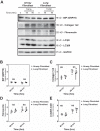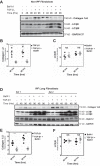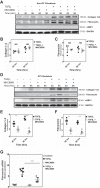Autophagy and the unfolded protein response promote profibrotic effects of TGF-β1 in human lung fibroblasts
- PMID: 29074489
- PMCID: PMC5900356
- DOI: 10.1152/ajplung.00372.2017
Autophagy and the unfolded protein response promote profibrotic effects of TGF-β1 in human lung fibroblasts
Abstract
Idiopathic pulmonary fibrosis (IPF) is a lethal fibrotic lung disease in adults with limited treatment options. Autophagy and the unfolded protein response (UPR), fundamental processes induced by cell stress, are dysregulated in lung fibroblasts and epithelial cells from humans with IPF. Human primary cultured lung parenchymal and airway fibroblasts from non-IPF and IPF donors were stimulated with transforming growth factor-β1 (TGF-β1) with or without inhibitors of autophagy or UPR (IRE1 inhibitor). Using immunoblotting, we monitored temporal changes in abundance of protein markers of autophagy (LC3βII and Atg5-12), UPR (BIP, IRE1α, and cleaved XBP1), and fibrosis (collagen 1α2 and fibronectin). Using fluorescent immunohistochemistry, we profiled autophagy (LC3βII) and UPR (BIP and XBP1) markers in human non-IPF and IPF lung tissue. TGF-β1-induced collagen 1α2 and fibronectin protein production was significantly higher in IPF lung fibroblasts compared with lung and airway fibroblasts from non-IPF donors. TGF-β1 induced the accumulation of LC3βII in parallel with collagen 1α2 and fibronectin, but autophagy marker content was significantly lower in lung fibroblasts from IPF subjects. TGF-β1-induced collagen and fibronectin biosynthesis was significantly reduced by inhibiting autophagy flux in fibroblasts from the lungs of non-IPF and IPF donors. Conversely, only in lung fibroblasts from IPF donors did TGF-β1 induce UPR markers. Treatment with an IRE1 inhibitor decreased TGF-β1-induced collagen 1α2 and fibronectin biosynthesis in IPF lung fibroblasts but not those from non-IPF donors. The IRE1 arm of the UPR response is uniquely induced by TGF-β1 in lung fibroblasts from human IPF donors and is required for excessive biosynthesis of collagen and fibronectin in these cells.
Keywords: IRE1; pulmonary fibrosis; spliced XBP1; transforming growth factor-β1.
Figures






Similar articles
-
Tubastatin ameliorates pulmonary fibrosis by targeting the TGFβ-PI3K-Akt pathway.PLoS One. 2017 Oct 18;12(10):e0186615. doi: 10.1371/journal.pone.0186615. eCollection 2017. PLoS One. 2017. PMID: 29045477 Free PMC article.
-
Novel Mechanisms for the Antifibrotic Action of Nintedanib.Am J Respir Cell Mol Biol. 2016 Jan;54(1):51-9. doi: 10.1165/rcmb.2014-0445OC. Am J Respir Cell Mol Biol. 2016. PMID: 26072676 Free PMC article.
-
The mannose-6-phosphate analogue, PXS64, inhibits fibrosis via TGF-β1 pathway in human lung fibroblasts.Immunol Lett. 2015 Jun;165(2):90-101. doi: 10.1016/j.imlet.2015.04.003. Epub 2015 Apr 27. Immunol Lett. 2015. PMID: 25929803
-
Angiotensin-TGF-beta 1 crosstalk in human idiopathic pulmonary fibrosis: autocrine mechanisms in myofibroblasts and macrophages.Curr Pharm Des. 2007;13(12):1247-56. doi: 10.2174/138161207780618885. Curr Pharm Des. 2007. PMID: 17504233 Review.
-
Idiopathic pulmonary fibrosis (IPF): disease pathophysiology, targets, and potential therapeutic interventions.Mol Cell Biochem. 2024 Sep;479(9):2181-2194. doi: 10.1007/s11010-023-04845-6. Epub 2023 Sep 14. Mol Cell Biochem. 2024. PMID: 37707699 Review.
Cited by
-
The Impact of Endoplasmic Reticulum-Associated Protein Modifications, Folding and Degradation on Lung Structure and Function.Front Physiol. 2021 May 25;12:665622. doi: 10.3389/fphys.2021.665622. eCollection 2021. Front Physiol. 2021. PMID: 34122136 Free PMC article. Review.
-
Pathological mechanisms and novel drug targets in fibrotic interstitial lung disease.Inflamm Regen. 2024 Jul 19;44(1):34. doi: 10.1186/s41232-024-00345-2. Inflamm Regen. 2024. PMID: 39026335 Free PMC article. Review.
-
Molecular and Genetic Biomarkers in Idiopathic Pulmonary Fibrosis: Where Are We Now?Biomedicines. 2023 Oct 16;11(10):2796. doi: 10.3390/biomedicines11102796. Biomedicines. 2023. PMID: 37893169 Free PMC article. Review.
-
Clinical progress in MSC-based therapies for the management of severe COVID-19.Cytokine Growth Factor Rev. 2022 Dec;68:25-36. doi: 10.1016/j.cytogfr.2022.07.002. Epub 2022 Jul 6. Cytokine Growth Factor Rev. 2022. PMID: 35843774 Free PMC article. Review.
-
Role of Inositol-Requiring Enzyme 1 and Autophagy in the Pro-Fibrotic Mechanism Underlying Graves' Orbitopathy.Yonsei Med J. 2024 Jul;65(7):397-405. doi: 10.3349/ymj.2023.0294. Yonsei Med J. 2024. PMID: 38910302 Free PMC article.
References
-
- Adamson YI, Bowden DH. Pulmonary injury and repair. Organ culture studies of murine lung after oxygen. Arch Pathol Lab Med 100: 640–643, 1976. - PubMed
-
- Araya J, Kojima J, Takasaka N, Ito S, Fujii S, Hara H, Yanagisawa H, Kobayashi K, Tsurushige C, Kawaishi M, Kamiya N, Hirano J, Odaka M, Morikawa T, Nishimura SL, Kawabata Y, Hano H, Nakayama K, Kuwano K. Insufficient autophagy in idiopathic pulmonary fibrosis. Am J Physiol Lung Cell Mol Physiol 304: L56–L69, 2013. doi:10.1152/ajplung.00213.2012. - DOI - PubMed
-
- Borges FT, Melo SA, Özdemir BC, Kato N, Revuelta I, Miller CA, Gattone VH II, LeBleu VS, Kalluri R. TGF-β1-containing exosomes from injured epithelial cells activate fibroblasts to initiate tissue regenerative responses and fibrosis. J Am Soc Nephrol 24: 385–392, 2013. doi:10.1681/ASN.2012101031. - DOI - PMC - PubMed
Publication types
MeSH terms
Substances
Grants and funding
LinkOut - more resources
Full Text Sources
Other Literature Sources
Miscellaneous

